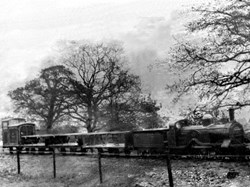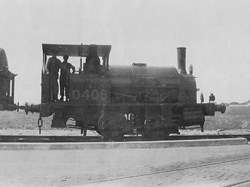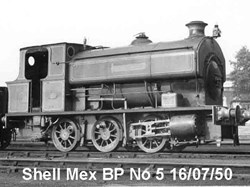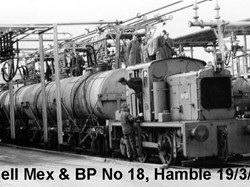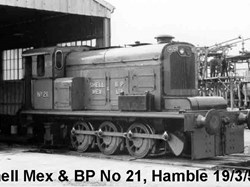Hamble's Railways
The first railway in the local area was a line from Southampton to Netley, which opened in 1866 and Hamble residents had to go to Netley terminus for a train. It had been envisaged that the railway would go to Fareham but due to lack of finances it did not get extended until 1889. This was a single line until it was made double track in 1911.
In the early 1900s there was a narrow gauge railway within the grounds of TS Mercury to transport goods, particularly coal to the pier to heat the training ships on which the boys slept. It was hoped to connect this to Netley but it was never built. During the First World War a railway line was constructed into Hamble to an Admiralty seaplane base, full details of this are given below.
After many years of requesting a station for Hamble, Hamble Halt was built in the Second World War to enable workers to get to the aircraft factories. It was opened in 1942 and a bus garage was built next to it to transport the workers to their workplace.
The railway line into Hamble - Depot
The railway into Hamble was built for No. 1 (Southern) Marine Acceptance Depot of the Admiralty, which was to be on the banks of Southampton Water, upstream from Hamble Common. The line was connected to the London and South Western Railway's Portsmouth - Southampton line near Hamble Lane road bridge in 1917 and was, and still is, known as 'Hamble Road Sidings', the road to the Depot being known as Hamble Road - part of it became Copse Lane many years later.
There was a system of narrow gauge lines during the building of the depot and associated barracks to the north of Hamble Lane. Immediately after crossing Hamble Lane for the second time, a siding was laid to assist in the construction of A V Roe's aircraft factory and aircraft, this later being used to bring in supplies, including coal. The line terminates by the square tower which was a feature of the Avro factory until it was demolished in recent years. A 1934 photograph shows half a dozen or so wagons parked on this line, but in 1936-37 a new hangar was built and the line rerouted, however, this arrangement was short lived as AST (Air Sevice Training) the then owners of the factory went over to oil-fired heating and the line was closed, the points being removed in 1939 or 1940.
Early in 1919 the building of the Acceptance Depot was abandoned, the only user, and later owner of the line being Avro. The motive power on the line in the early days seems to have been a War Department six-wheeled saddle-tank engine, which it appears Avro hired as and when required.
According to an official BP booklet, the site of the Acceptance Depot was purchased by Shell Mex in 1923 (it became Shell Mex and BP Ltd in 1932) for a site for an oil installation, the first oil rail tanker being hauled to Hamble Road Sidings by carthorses from Hamble Village.
The Locomotives
Records indicate that various Southern Railway locomotives were loaned to Shell Mex in the early 1920's, but in 1926 they purchased their own locomotive from the War Department at Bramley. It was delivered in February, became No.5 and worked the line until 1950.
A loco shed was built for No. 5, its location was where Spitfire Way and Barton Drive now meet, about where the lamp post is. No. 5 was always kept in an immaculate condition with a green livery lined in black and white, burnished copper pipes, fittings and chimney. It was assisted later by various small petrol or diesel locos which rarely left the bounds of the installation, and when No. 5 was away for heavy repairs its place was taken by Southern Railway engines. Three goods trains called at Hamble Road Sidings for SM & BP trade in 1938 and this number had doubled by 1948, so it can be seen that she was kept busy.
During 1943 a third line was laid at Hamble Road Sidings, floodlights being installed at the same time, whilst the track inside the depot was altered to suit the requirements of the period.
In 1950 two diesels locos arrived, No. 21 on 15th April 1950 and No. 18 in August 1950. No. 5 after many years of good service was sold for scrap, leaving Hamble on 22nd June 1950 whilst its smaller partner at the time, No. 13, left on 19th September 1950 - the latter by road.
During the late 1950's the track was completely relaid to enable the heavier tank cars coming into use to be used on the line. The engine shed was re-sited within the SM & BP depot and the original brick shed demolished, the siding to it became a loop, which at the time of writing September 1999 can still be seen.
1967 saw the arrival of a larger diesel loco, No. 24 and subsequently No. 21 and No. 18 left, No. 21 being "loaned" to the Mid Hants Railway and was last seen on a siding near Alton. No. 18 - which was built for the War Department in 1942 has defied research, its fate is unknown.
When it was decided that Hamble was to be the terminal for Wytch Farm oil, the method of getting the oil to the terminal had to be evaluated, rail being one of the methods considered. A four month period of test trains was arranged, the first to arrive was on 26th July 1985 and consisted of 10 bogie tanks with two BR Electro-Diesels of the '73' class and loco 11, one at either end. The second train was worked by BP 'No. 24' which unfortunately broke down in the middle of Hamble Lane causing more than a few people to be late for work. Thereafter, trains were worked from Hamble Road Sidings by a British Rail diesel-electric 400hp shunter until trials finished in December 1985. It was decided that a pipeline would be the preferred method, but until it was laid the oil went to the Esso refinery at Fawley.
BP locos 18, 21 and 24 were unusual in that they had a revolving orange light on their roof, as when the wind was in a NE or SW direction their track crossed the runway of the airfield, and the flashing light gave warning to aircraft.
In the 1980's there were several passenger carrying trains seen on the line organised by railway enthusiast clubs and societies, but these stopped short of the second crossing over Hamble Lane and did not enter the depot, and were worked by Diesel-Electric units.
The line has not been used since December 1985, No. 24 left in 1986 and the lines inside the terminal were taken up. The line outside remains in position and can be followed over most of its length on the Hamble Rail Trail (still one piece missing September 1999).
In November 1992 another loco arrived and was parked on the line opposite the surgery in Copse Lane. It was painted maroon and named "The Man of Kent" having come from the then recently closed Isle of Grain depot. During 1993 it was repainted BP road tanker colours and was named "Hamble-le-Rice" during week ending 13th March 1993. It never strayed outside the terminal gate and during 1998 was moved to another BP site, but it is still on Hamble Terminal's "books".
The Future
During a recent conversation with a BP official it was stated that, although at the moment they have no use for the line, they do not intend to give the line up.
© Tony Sedgwick 1999 (photographs from Tony Sedgwick's collection)
